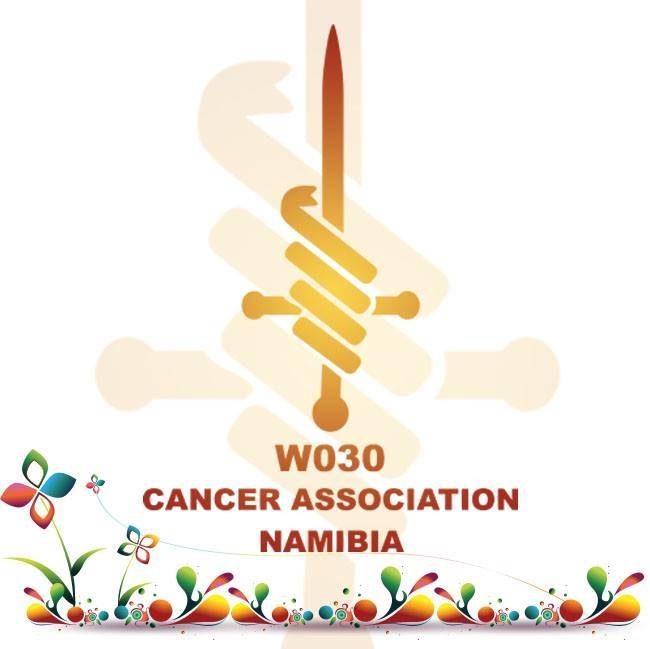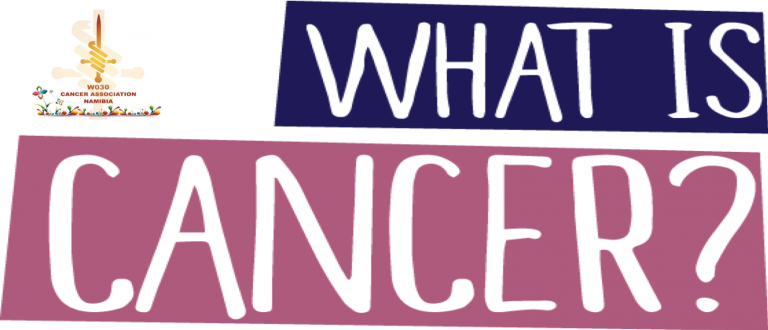Cancer starts when cells change abnormally
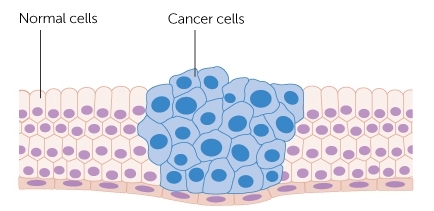
Cancer is when abnormal cells divide in an uncontrolled way. Some cancers may eventually spread into other tissues.
There are more than 200 different types of cancer.
1 in 2 people will get cancer in their lifetime.
Thanks to research many people are cure.
Cell changes and cancer
All cancers begin in cells. Our bodies are made up of more than a hundred million million (100,000,000,000,000) cells. Cancer starts with changes in one cell or a small group of cells.
Usually, we have just the right number of each type of cell. This is because cells produce signals to control how much and how often the cells divide. If any of these signals are faulty or missing, cells may start to grow and multiply too much and form a lump called a tumour. A primary tumour is where the cancer starts.
Some types of cancer, called leukaemia, start from blood cells. They don’t form solid tumours. Instead, the cancer cells build up in the blood and sometimes the bone marrow.
For a cancer to start, certain changes take place within the genes of a cell or a group of cells.
Gene changes within cells (mutations)
Normally genes make sure that cells grow and reproduce in an orderly and controlled way. They make sure that all the cells produced are needed to keep the body healthy.
Sometimes a change happens in the genes when a cell divides. This is a mutation. It means that a gene has been damaged or lost or copied twice. Mutations can happen by chance when a cell is dividing. Some mutations mean that the cell no longer understands its instructions and starts to grow out of control. There have to be about half a dozen different mutations before a normal cell turns into a cancer cell.
Mutations in particular genes may mean that a cell starts producing too many proteins that trigger a cell to divide. Or it stops producing proteins that normally tell a cell to stop dividing. Abnormal proteins may be produced that work differently to normal.
Genes and cell division
Different types of cells in the body do different jobs, but they are basically similar. They all have a control centre called a nucleus. Inside the nucleus are chromosomes made up of thousands of genes. Genes contain long strings of DNA (deoxyribonucleic acid), which are coded messages that tell the cell how to behave.
Each gene is an instruction that tells the cell to make something. This could be a protein or a different type of molecule called RNA. Together, proteins and RNA control the cell. They decide what sort of cell it will be, what it does, when it will divide, and when it will die.
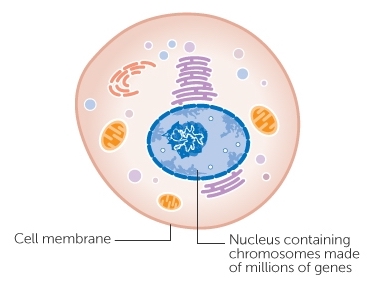
How mutations happen
Mutations can happen by chance when a cell is dividing. They can also be caused by the processes of life inside the cell. Or by things coming from outside the body, such as the chemicals in tobacco smoke. And some people can inherit faults in particular genes that make them more likely to develop a cancer.
Some genes get damaged every day and cells are very good at repairing them. But over time, the damage may build up. And once cells start growing too fast, they are more likely to pick up further mutations and less likely to be able to repair the damaged genes.
Cancer grows as cells multiply over and over
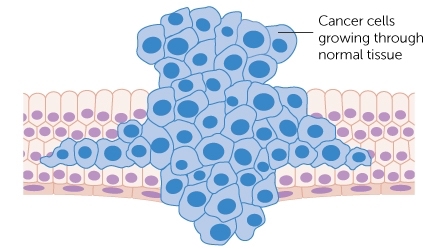
How cancers get bigger
To start with, cancer cells stay within the body tissue from which they have developed – for example, the lining of the bladder or the breast ducts. Doctors call this superficial cancer growth or carcinoma in situ.
The cancer cells grow and divide to create more cells and will eventually form a tumour. A tumour may contain millions of cancer cells.
All body tissues have a layer (a membrane) that keeps the cells of that tissue inside. This is the basement membrane. Cancer cells can break through this membrane. If this happens, the cancer is called invasive.
How cancer spreads into surrounding tissues
As a tumour gets bigger, it takes up more space in the body. The cancer can then cause pressure on surrounding structures. It can also grow into body structures nearby. This is called local invasion. How a cancer actually grows into the surrounding tissues is not fully understood.
A cancer may grow out in a random direction from the place where it started. However, researchers know that tumours can spread into some tissues more easily than others. For example, large blood vessels that have strong walls and dense tissues such as cartilage are hard for tumours to grow into. So, tumours usually grow along the ‘path of least resistance’. This means that they probably take the easiest route.
Research has found 3 different ways that tumours may grow into surrounding tissues. A tumour will probably use all 3 of these ways of spreading. Which way is used most depends on the type of tumour, and where in the body it is growing.
The 3 ways that tumours may grow into surrounding tissues are explained below.

The finger like appearance of the growth happens because it is easier for the growing cancer to force its way through some paths than others. For example, cancers may grow between sheets of muscle tissue rather than straight through the muscle.
As the cancer grows, it will squeeze and block small blood vessels in the area. Due to low blood and oxygen levels, some of the normal tissue will begin to die off. This makes it easier for the cancer to continue to push its way through.
Cancer cells moving through the tissue
One of the things that makes cancer cells different to normal cells is that they can move about more easily. So it seems likely that one of the ways that cancers spread through nearby tissues is by the cells directly moving.
Scientists have discovered a substance made by cancer cells which stimulates them to move. They don’t know for sure yet, but it seems likely that this substance plays a big part in the local spread of cancers.
This research is interesting because, if a substance can help cancer cells move, then researchers can look for ways to stop the substance working. They may also be able to find ways to stop the cancer cells making the substance in the first place.
Cancer starts when gene changes make one cell or a few cells begin to grow and multiply too much. This may cause a growth called a tumour.
Benign and cancerous (malignant) tumours
Tumours (lumps) can be benign or cancerous (malignant). Benign means it is not cancer.
Benign tumours
- Usually grow quite slowly
- Don’t spread to other parts of the body
- Usually have a covering made up of normal cells
Benign tumours are made up of cells that are quite similar to normal cells. They will only cause a problem if they:
- grow very large
- become uncomfortable or painful
- are visible and unpleasant to look at
- press on other body organs
- take up space inside the skull (such as a brain tumour)
- release hormones that affect how the body works
Malignant tumours are made up of cancer cells. They:
- usually grow faster than benign tumours
- spread into surrounding tissues and cause damage
- may spread to other parts of the body in the bloodstream or through the lymph system to form secondary tumours. This is called metastasis
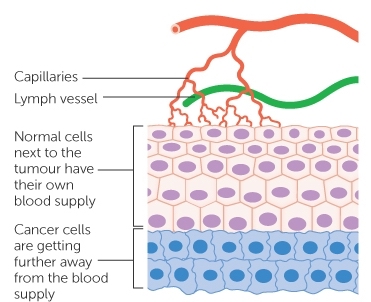
Blood supply and cancer
As the tumour gets bigger, its centre gets further and further away from the blood vessels in the area where it is growing. So the centre of the tumour gets less and less oxygen and nutrients.
Like healthy cells, cancer cells cannot live without oxygen and nutrients. So they send out signals, called angiogenic factors, that encourage new blood vessels to grow into the tumour. This is called angiogenesis. Without a blood supply, a tumour can’t grow much bigger than a pin head.
Once a cancer can stimulate blood vessel growth, it can grow bigger and rapidly. It stimulates the growth of hundreds of new small blood vessels (capillaries) to bring in nutrients and oxygen.
Using enzymes
Some normal cells produce chemicals called enzymes that break down cells and tissues. The cells use the enzymes to attack invading bacteria and viruses. They also use them to break down and clear up damaged areas in the body. This is all part of the natural healing process.
Many cancers contain larger amounts of these enzymes. Some cancers also contain a lot of normal white blood cells, which produce the enzymes. They are part of the body’s immune response to the cancer. Researchers are not yet sure where the enzymes come from, but they are likely to make it easier for the cancer to spread through the healthy tissue.
As the cancer pushes through and breaks down normal tissues, it may cause bleeding due to damage to nearby blood vessels.
Some cancers can spread to other parts of the body
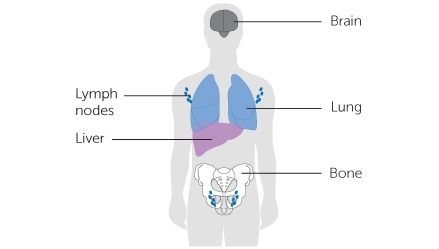
How cancer can spread to other areas of the body
Cancer cells can spread to other parts of the body through the bloodstream or lymphatic system. There they can start to grow into new tumours.
Cancers are named according to where they first started developing. For example, if you have bowel cancer that has spread to the liver, it’s called bowel cancer with liver metastases or secondaries. It is not called liver cancer. This is because the cancerous cells in the liver are actually cancerous bowel cells. They are not liver cells that have become cancerous.
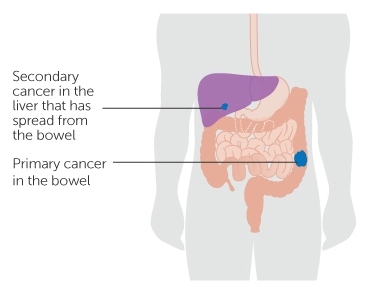
In order to spread, some cells from the primary cancer must break away, travel to another part of the body and start growing there. Cancer cells don’t stick together as well as normal cells do. They may also produce substances that stimulate them to move.
The diagram below shows a tumour in the cells lining a body structure such as the bowel wall. The tumour grows through the layer holding the cells in place (the basement membrane). Some cells can break away and go into small lymph vessels or blood vessels called capillaries in the area.
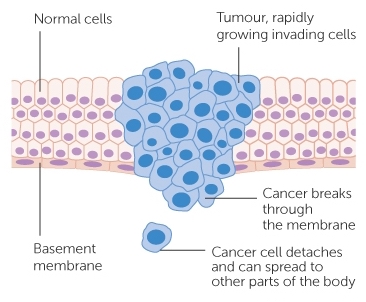
Spread through the lymphatic system
The lymphatic system is a network of tubes and glands in the body that filters body fluid and fights infection. It also traps damaged or harmful cells such as cancer cells.
Cancer cells can go into the small lymph vessels close to the primary tumour and travel into nearby lymph glands. In the lymph glands, the cancer cells may be destroyed but some may survive and grow to form tumours in one or more lymph nodes. Doctors call this lymph node spread.
A primary tumour is the name for where a cancer starts.
Cancer can sometimes spread to other parts of the body – this is called a secondary tumour or a metastasis.
Cancer and its treatments can affect body systems, such as the blood circulation, lymphatic and immune systems, and the hormone system.
Primary and secondary cancer
The place where a cancer starts in the body is called the primary cancer or primary site. Cells from the primary site may break away and spread to other parts of the body. These escaped cells can then grow and form other tumours, which are known as secondary cancers or metastases.
Spread through the blood circulation
When the cancer cells go into small blood vessels they can then get into the bloodstream. They are called circulating tumour cells (or CTCs).
Researchers are currently looking at using circulating tumour cells to diagnose cancer and avoid the need for tests such as biopsies. They are also looking at whether they can test circulating cancer cells to predict which treatments will work better.
The circulating blood sweeps the cancer cells along until they get stuck somewhere. Usually they get stuck in a very small blood vessel such as a capillary.
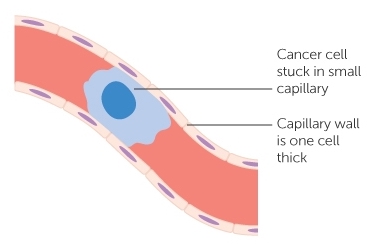
Then the cancer cell must move through the wall of the capillary and into the tissue of the organ close by. The cell can multiply to form a new tumour if the conditions are right for it to grow and it has the nutrients that it needs.
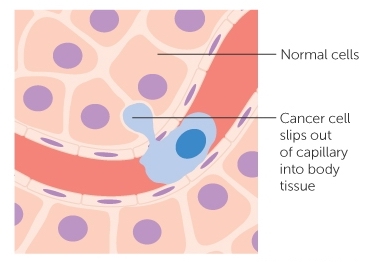
This is quite a complicated process and most cancer cells don’t survive it. Probably, out of many thousands of cancer cells that reach the bloodstream, only a few will survive to form a secondary cancer.
Some cancer cells are probably killed off by the white blood cells in our immune system. Others cancer cells may die because they get battered around by the fast flowing blood.
Cancer cells in the circulation may try to stick to platelets to form clumps to give themselves some protection. Platelets are blood cells that help the blood to clot. This may also help the cancer cells to move into the surrounding tissues.
Is cancer genetic?
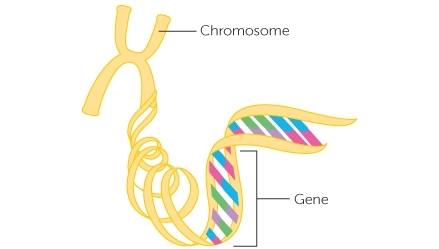
DNA stands for deoxyribonucleic acid (pronounced dee-oxy-rye-bow-nu-clay-ik acid). Each string of DNA looks like a twisted ladder. Scientists call this a double helix.
You have more than 2 metres of DNA inside every cell, but it is very tightly coiled up so it all fits. DNA is like a code containing all the instructions that tell a cell what to do. It is made up of genes. Humans have around 25,000 genes in total.
You inherit half your DNA from your mother and half from your father, so you have 2 copies of every gene.
Your genes carry all the information that makes you, you. They tell your body to have blonde hair, or brown skin, or green eyes for example. And they tell your cells what sort of cell to be, how to behave, when to grow and reproduce, and when to die.
Some genes control how much each cell grows and divides.
How faulty genes lead to cancer
Our genes pick up mistakes that occur when cells divide. These mistakes (or faults) are called mutations. Mutations can happen throughout our lives, during natural processes in our cells. Or they can happen because of other factors such as:
- tobacco smoke
- radiation
- ultraviolet radiation from the sun
- some substances in food
- chemicals in our environment
Sometimes people inherit certain faulty genes from their parents. This can give them an increased risk of cancer.
Usually, cells can repair faults in their genes. When the damage is very bad, the cell may self destruct instead. Or the immune system may recognise them as abnormal and kill them. This helps to protect us from cancer.
Sometimes mutations in important genes cause a cell to no longer understand instructions. The cell can start to multiply out of control. It doesn’t repair itself properly, and it doesn’t die when it should. This can lead to cancer.
There are 4 main types of genes involved in cell division. Most tumours have faulty copies of more than 1 of these types.
Genes that repair other damaged genes (DNA repair genes)
The DNA in every cell in our body is constantly in danger of becoming damaged. But cells contain many different proteins whose job is to repair damaged DNA. Thanks to these proteins, most DNA damage gets repaired immediately, with no ill effects.
But if the DNA damage occurs to a gene that makes a DNA repair protein, a cell has less ability to repair itself. So errors will build up in other genes over time and allow a cancer to form.
Scientists have found damaged DNA repair genes in some cancers, including bowel cancer.
DNA and genes
Inside almost every cell in your body is a structure called the nucleus, which is the control centre of the cell. Inside the nucleus are 23 pairs of chromosomes. These are long strings of DNA.
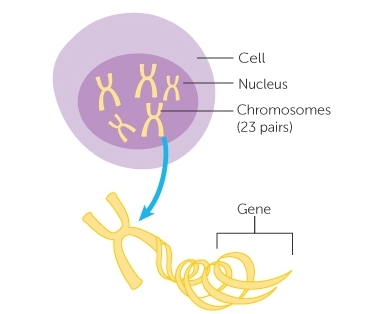
Genes that encourage the cell to multiply (oncogenes)
Oncogenes are genes that, under normal circumstances, tell cells to multiply and divide. Usually in adults, this would not happen very often.
We can think of oncogenes as being a bit like the accelerator pedal in a car. When they become active, they speed up a cell’s growth rate. When one becomes damaged, it is like the accelerator pedal becoming stuck down. That cell, and all the cells that grow from it, are permanently instructed to divide. So a cancer develops.
Genes that stop the cell multiplying (tumour suppressor genes)
Usually, cells can repair faults in their genes. When the damage is very bad, tumour suppressor genes may stop the cell growing and dividing.
Mutations in tumour suppressor genes mean that a cell no longer understands the instruction to stop growing. The cell can then start to multiply out of control. This can lead to cancer.
The best known tumour suppressor gene is p53. Researchers know that the p53 gene is damaged or missing in most cancers.
Genes that tell a cell to die (self destruction genes)
Some genes normally tell a cell to self destruct if it has become too old or damaged. This is called apoptosis or programmed cell death. It is a highly complex and very important process. Cells usually die whenever something goes wrong, to prevent a cancer forming.
There are many different genes and proteins involved in apoptosis. If these genes get damaged, a faulty cell can survive rather than die and it becomes cancerous.

